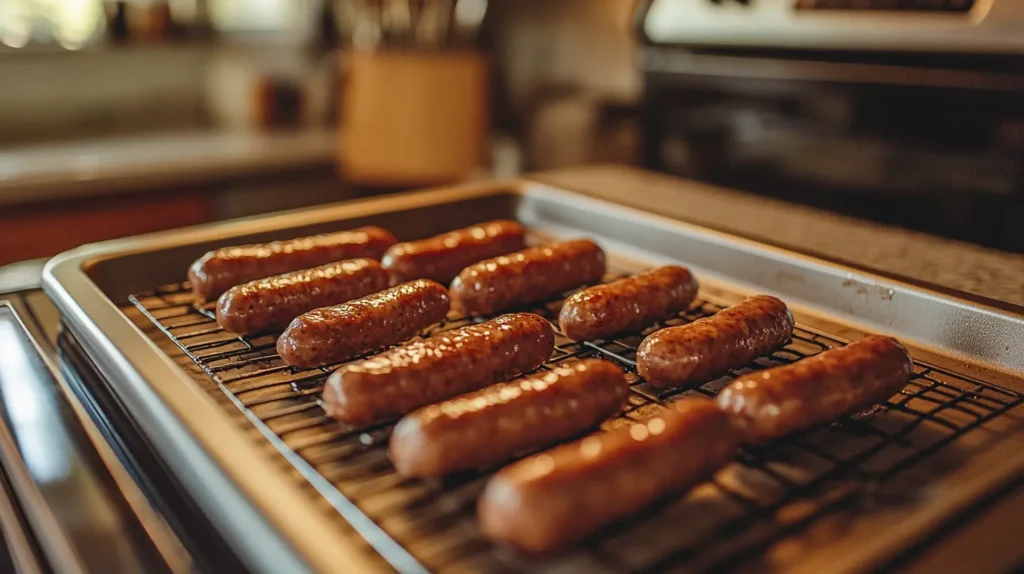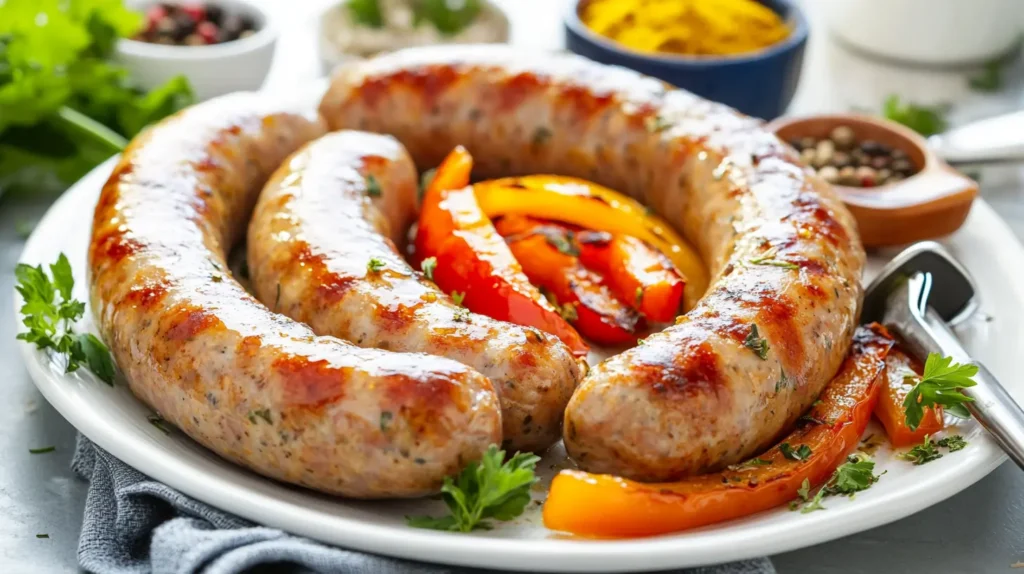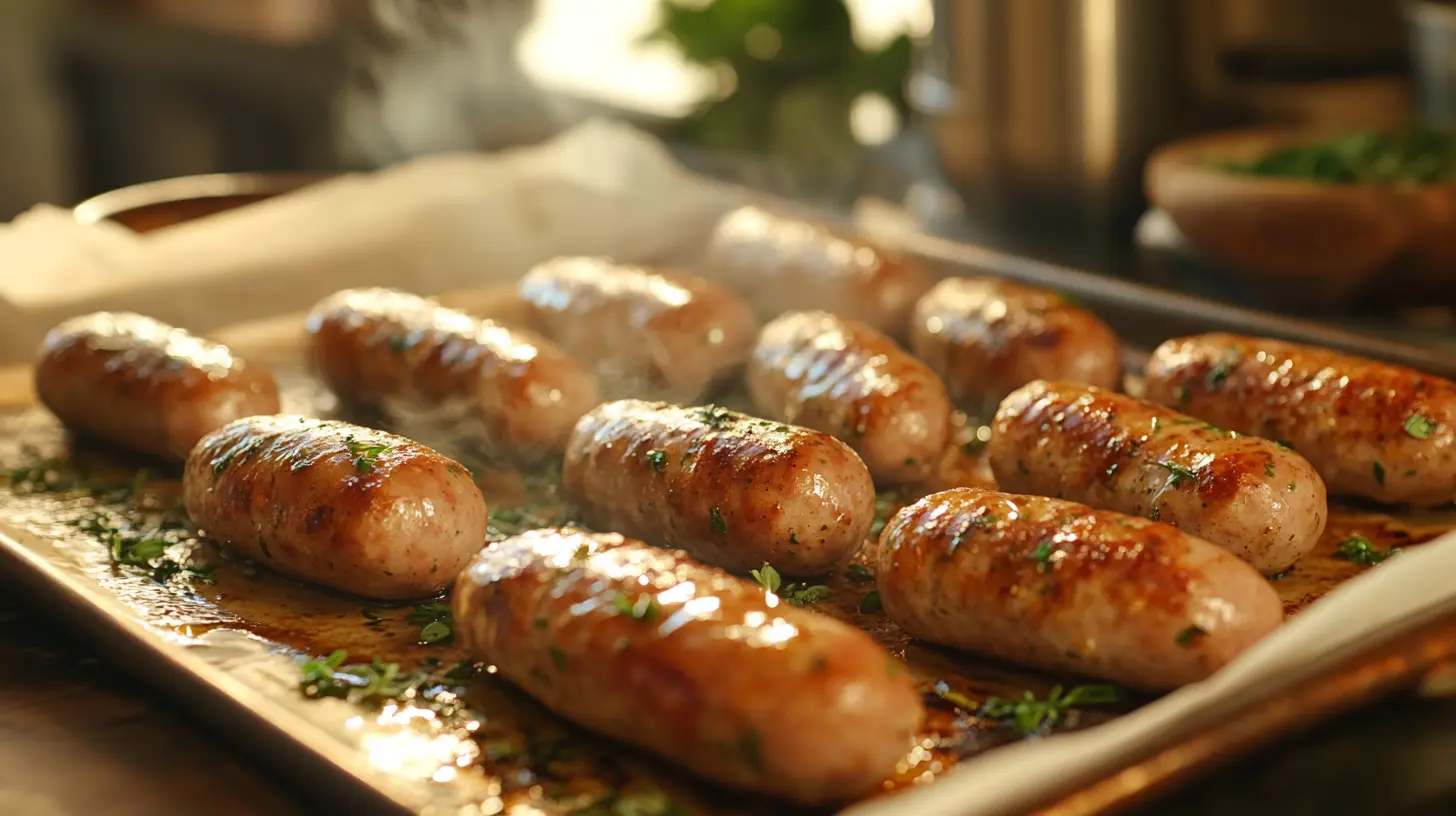Learn how to prepare breakfast sausage in the oven with ease, speed, and unbeatable flavor.
Why Learn to Cook Breakfast Sausage in the Oven?
In this article, you will learn how to prepare breakfast sausage in the oven using simple techniques and expert tips. We will cover everything from selecting the right sausage to adjusting the cooking time for various sausage types. How to prepare breakfast sausage in the oven can save you time, reduce mess, and ensure even cooking. For more background on meat safety, consider checking authoritative sources, such as USDA Food Safety. Additionally, learn about oven-baking techniques from reliable cooking references, like Serious Eats. In fact, you might also find insights about meat preparation on The Spruce Eats.
What This Guide Will Cover
In the following guide, we will detail the best practices for baking sausages, compare different varieties, and show you how to achieve perfect browning. Moreover, we will share tips for pairing your oven-baked breakfast sausages with delightful sides, such as our breakfast potato recipes available on our site. By the time you finish reading, you will be ready to transform any morning meal into a hearty and flavorful feast. Keep reading to discover how to prepare breakfast sausage in the oven confidently and consistently.
Part 1
1. Introduction to Cooking Breakfast Sausage in the Oven
When learning how to prepare breakfast sausage in the oven, many home cooks find it simpler than pan-frying. How to prepare breakfast sausage in the oven involves fewer splatters, less smoke, and minimal tending. Consequently, you will enjoy a smooth cooking experience. Another benefit is the even heat distribution inside the oven, which helps achieve uniform browning. Additionally, oven-baking often locks in moisture, ensuring juicy and flavorful bites.
Moreover, oven-baking accommodates different sausage types, from savory classic pork links to chicken or beef variants. Because the oven applies consistent heat, you can customize your cooking times and temperatures easily. Generally, preheating, proper placement, and correct timing ensure well-cooked sausages. Indeed, once you master this method, you will rarely return to stovetop frying for breakfast sausages. Basically, how to prepare breakfast sausage in the oven offers a stress-free approach, perfect for busy mornings, brunch gatherings, and meal prep scenarios.
2. Understanding Breakfast Sausage Varieties
Fresh vs. Pre-Cooked Sausages
Before you learn exactly how to prepare breakfast sausage in the oven, it helps to know the differences between sausage types. Firstly, there are fresh sausages, which are raw and require thorough cooking. Secondly, there are pre-cooked sausages, which only need heating and browning.
Links vs. Patties
Another variation is links vs. patties. Patties are formed from ground meat mixtures, while links come in casings.
Flavored Options
Basically, you can choose pork, beef, chicken, turkey, or even plant-based options. Flavored varieties, e.g., maple or spicy, add unique tastes to your meal. Moreover, some sausages feature sweet syrup glazes, whereas others contain herbs and spices. Comparatively, milder sausages pair well with classic breakfast items, while spicier ones stand out on their own. Indeed, the sausage style you pick influences cooking temperatures and times. Identically, fresh sausages often need longer baking, while pre-cooked options require a shorter duration.
3. Selecting the Right Sausage for Oven Cooking
Choosing quality sausages is crucial. In general, read packaging labels to identify ingredients and ensure they meet your dietary preferences. Undoubtedly, look for sausages made with high-quality meats and limited fillers. Another tip is to select sausages from reputable butcher shops or trusted brands. Certainly, fresh sausages often provide more flavor depth than heavily processed ones.
Additionally, consider whether you want seasoned or unseasoned options. If you prefer adjusting flavors yourself, go for plain sausages and add spices later. Conversely, if you enjoy convenience, pre-seasoned sausages save time. Correspondingly, consider the casing type. Natural casings offer a firm, snappy bite, whereas synthetic casings may feel softer.
4. Necessary Equipment and Tools
Essential Tools
To master how to prepare breakfast sausage in the oven, gather some basic tools.
- Baking sheet or tray: Ideally with raised edges to catch drippings.
- Wire rack: Promotes even cooking and crisping.
- Parchment paper or foil: Simplifies cleanup and prevents sticking.
- Meat thermometer: Ensures sausages reach safe internal temperatures.
Additional Items
Consider silicone baking mats to prevent sticking. Using a rack encourages hot air circulation. Another recommended tool is a pair of tongs for flipping sausages midway.

5. Preheating the Oven
Temperature Guidelines
Preheating is essential. Generally, 400°F (204°C) works well for many breakfast sausages. Nevertheless, adjust the temperature according to package instructions or personal preference.
Adjusting for Different Sausage Types
Occasionally, chicken or turkey sausages benefit from 375°F (191°C) to prevent over-drying. Conversely, thicker sausages may need higher heat for crisp exteriors.
6. Preparing Sausages for the Oven
Thawing and Seasoning
First, thaw frozen sausages beforehand, or alternatively, adjust cooking times if baking them from a frozen state. Next, pat the sausages dry to remove any excess moisture. Afterward, lightly brush each sausage with oil or melted butter to enhance browning. Finally, consider adding dried herbs or spices to boost their overall flavor depth.
Arranging on the Tray
Spread sausages out so they do not touch, allowing heat to circulate. Consider flipping halfway through to brown all sides evenly.
7. Cooking Techniques and Timing
General Timing Guidelines
- Fresh pork sausages: ~20-25 minutes at 400°F (204°C).
- Pre-cooked sausages: ~10-15 minutes to warm through.
- Chicken or turkey: Slightly less time due to leaner meat.
Flip sausages halfway for even browning. Adjust times based on thickness. Practice helps you find the sweet spot for perfect doneness.
8. Monitoring Sausage Temperature
Safe Internal Temperatures
- Pork: At least 160°F (71°C)
- Chicken/turkey: At least 165°F (74°C)
Insert the thermometer into the thickest part. Ensuring proper doneness prevents illness and keeps sausages juicy.
9. Adding Vegetables or Sides During Baking
One-Tray Meals
Add bell peppers, onions, or mushrooms. Include diced potatoes or carrots. Adjust cook times so all finish together. This approach simplifies breakfast prep and adds variety.
10. Troubleshooting Common Issues
Common Problems and Fixes
- Dry sausages: Lower temperature or shorten cook time.
- Uneven browning: Flip halfway, space out sausages, or rotate the tray.
- Sticking: Use parchment, foil, or lightly oil the rack.
Practice leads to consistent, delicious results.
Part 2
11. Enhancing Flavor and Presentation
Finishing Touches
Glaze sausages with maple syrup, honey, mustard, or barbecue sauce. Add fresh herbs like thyme or rosemary. Serve with colorful fruits or roasted veggies for an appealing meal.
12. Baking Sausages for Meal Prep
Meal Prep Tips
First, cook a large batch and store it in airtight containers. Next, reheat portions throughout the week as needed. For longer storage, freeze the sausages until you are ready to use them. Moreover, consider incorporating any leftovers into omelets, burritos, or casseroles. As a result, meal prep becomes effortless when you rely on oven-baked sausages.
13. Cleaning Up After Cooking
Easy Cleanup Methods
First, line trays with foil or parchment for easier cleanup. Next, soak any soiled baking sheets in warm, soapy water to loosen stuck-on residue. After that, dispose of grease in a heat-resistant container to prevent drain clogs. Additionally, wipe oven interiors regularly to maintain a hygienic cooking environment. Ultimately, a clean kitchen encourages ongoing culinary exploration.
14. Nutritional Insights of Breakfast Sausage
Health Considerations
- Pork: Higher fat content.
- Turkey/chicken: Leaner and lower fat.
- Baking reduces need for extra oil, making it healthier than frying.
Pair with whole grains, fruits, and veggies for a balanced meal.
15. Exploring Alternative Cooking Methods
Comparing Different Methods
- Pan-frying: Crisp but messier.
- Grilling: Smoky flavor, outdoor space needed.
- Air frying: Less grease, smaller batches.
- Poaching: Tender but less browned.
Experiment to find your favorite style while appreciating oven convenience.
16. Customizing Homemade Breakfast Sausages
Homemade Basics
First, make sausages from scratch using ground pork, turkey, or chicken. Next, season the mixture with salt, pepper, herbs, and spices according to your taste. Then, shape the blend into patties or use casings for a more traditional appearance. Ultimately, personalizing recipes in this manner unlocks endless culinary creativity..
17. Cooking Frozen Sausages Without Thawing
Adjusting for Frozen State
Increase baking time by 5-10 minutes. Ensure internal temperature is safe. Flip halfway for even cooking. Convenient for last-minute meals.
18. Vegan and Plant-Based Sausage Options
Plant-Based Tips
Choose sausages from soy, pea protein, or wheat gluten. Follow package instructions. Serve with roasted veggies or whole-grain toast. Oven-baking accommodates all dietary preferences.
19. Serving Sausages with Complementary Breakfast Items

Flavorful Pairings
Serve with scrambled eggs, pancakes, or fruit. Maple-glazed sausages and cinnamon oatmeal. Spicy sausages and avocado toast. Bright salads add freshness. Elevate the entire meal through thoughtful pairings.
20. Tips for Cooking Sausages for a Crowd
Bulk Cooking Strategies
First, line multiple trays with parchment paper. Next, space the sausages evenly to promote uniform cooking. Then, rotate the trays halfway through the cooking process to ensure even browning. Afterward, keep the cooked sausages warm in a low oven. Ultimately, by following these steps, you can host large gatherings with ease
Part 3
21. Regional Variations in Breakfast Sausage Preparation
Exploring Global Styles
American vs. British “bangers,” unique herbs, and sweet vs. herbal notes. Experiment with cultural differences to broaden your culinary horizons.
22. Experimenting with Oven Temperature and Techniques
Temperature Tweaks
Try lower and slower (350°F) for tenderness. Go higher (425°F) for crispness. Use convection for even heat. Continuous experimentation refines your technique.
23. Sausage Safety and Storage Tips
Safe Handling
Store raw sausages in the fridge. Cook before expiration. Freeze if not using soon. Refrigerate leftovers and consume within a few days. Safe habits ensure trouble-free meals.
24. Creating Flavor Profiles with Seasonings
Seasoning Ideas
Paprika, cumin, or black pepper add complexity. Brown sugar or maple syrup add sweetness. Garlic, rosemary, or sage for savory depth. Avoid flavor monotony by mixing it up.
25. Exploring Sausage Cooking Recipes Beyond Breakfast
Versatile Uses
Slice leftover sausages into pasta, casseroles, or soups. Top flatbread with sausage and cheese. Pair with roasted vegetables or grain bowls. Your oven-baking skills extend beyond mornings.
26. Hosting a Breakfast Sausage Tasting Party
Party Suggestions
Offer various types, label each tray, and provide mustards, syrups, and fruit chutneys. Serve coffee, tea, or fresh juices. Turn simple breakfasts into memorable events.
27. Popular Brands and Homemade Alternatives
Store-Bought vs. Homemade
Artisanal sausages offer unique flavors. Homemade versions allow total control. Both benefit from oven-baking. Explore different options for diverse experiences.
28. Sausage Texture Preferences and Adjustments
Tailoring Textures
For crispier sausages, bake longer or position closer to the top rack. For juicier results, reduce cooking time slightly. Customize textures to personal taste.
29. Common Mistakes in Sausage Baking
Pitfalls to Avoid
Do not overcrowd trays. Flip sausages halfway. Check internal temperatures. Attention to detail ensures perfect results every time.
30. Final Tips for Perfect Oven-Cooked Sausages
Recap
First, choose quality sausages and preheat the oven to the recommended temperature. Next, space the sausages out on the baking sheet so they cook evenly. Then, flip them halfway through the cooking process, checking their temperatures and adding seasonings as desired. Ultimately, with regular practice, you will refine the timing, texture, and presentation of your dishes. Consequently, you now know how to prepare breakfast sausage in the oven with confidence.
Frequently Asked Questions (FAQs)
How do you cook sausages in the oven?
Preheat the oven to about 400°F (204°C). Line a baking sheet with foil or parchment for easy cleanup. Place sausages in a single layer, spaced apart, and bake for about 20-25 minutes for fresh sausages, flipping them halfway through. Check their internal temperature with a meat thermometer to ensure it reaches at least 160°F (71°C) for pork or 165°F (74°C) for poultry sausages.
What is the best way to cook breakfast sausages?
Oven-baking is an excellent method. It ensures even cooking, reduces splatters, and allows you to multitask. Oven-cooked sausages develop a lovely, browned exterior and remain juicy inside. This approach also makes it simple to cook multiple batches simultaneously, saving time when feeding a crowd.
Is it better to cook sausages in the oven or pan?
Oven-baking and pan-frying both have merits. Oven-baking is comparatively cleaner, simpler, and can handle larger quantities. Pan-frying provides more control over browning but requires more attention and can be messier. If you prefer a no-fuss, hands-off approach, the oven method is often better.
How do I cook sausages in the oven without making a mess?
Line your baking sheet with foil or parchment paper. A wire rack above the sheet helps grease drip away from sausages, minimizing sticking. Avoid overcrowding, which leads to pooling grease. Afterward, soak pans promptly for easier cleaning. Proper preparation and cleanup steps ensure less mess overall.
